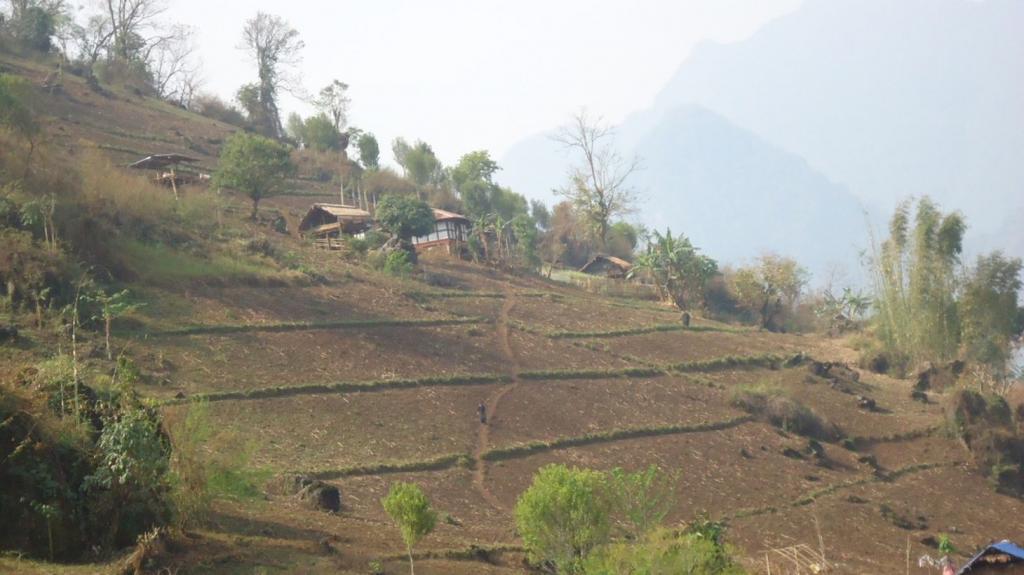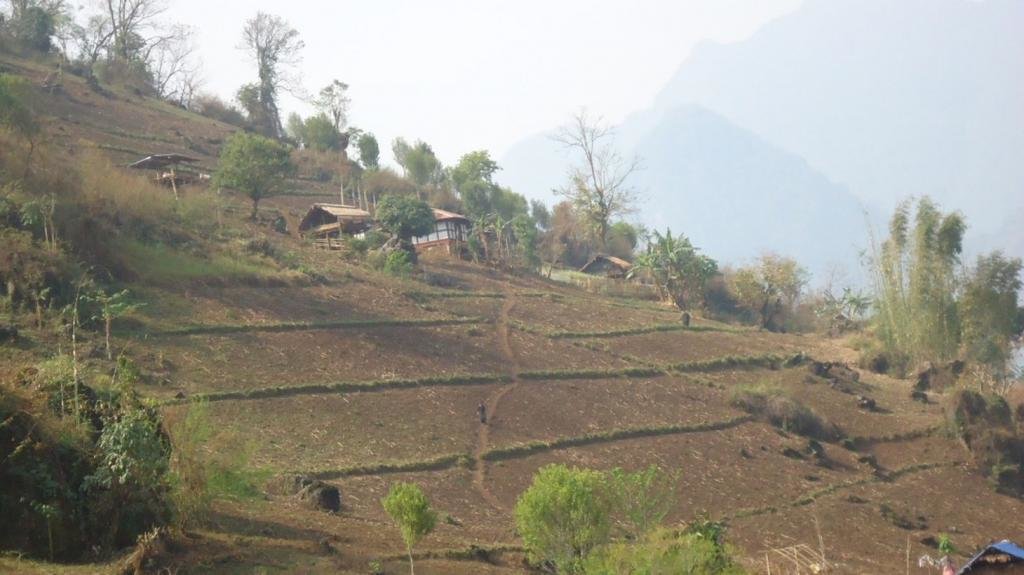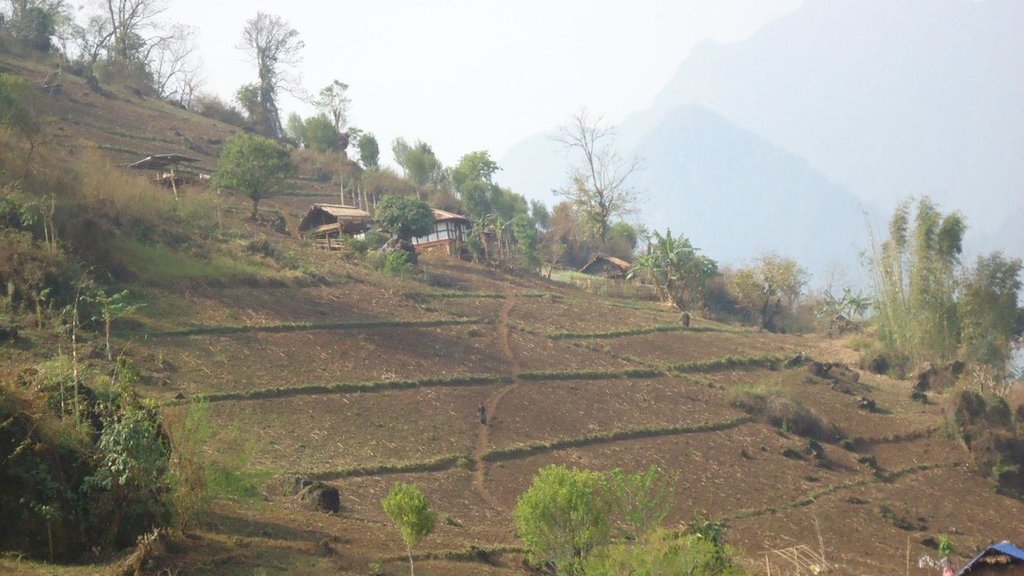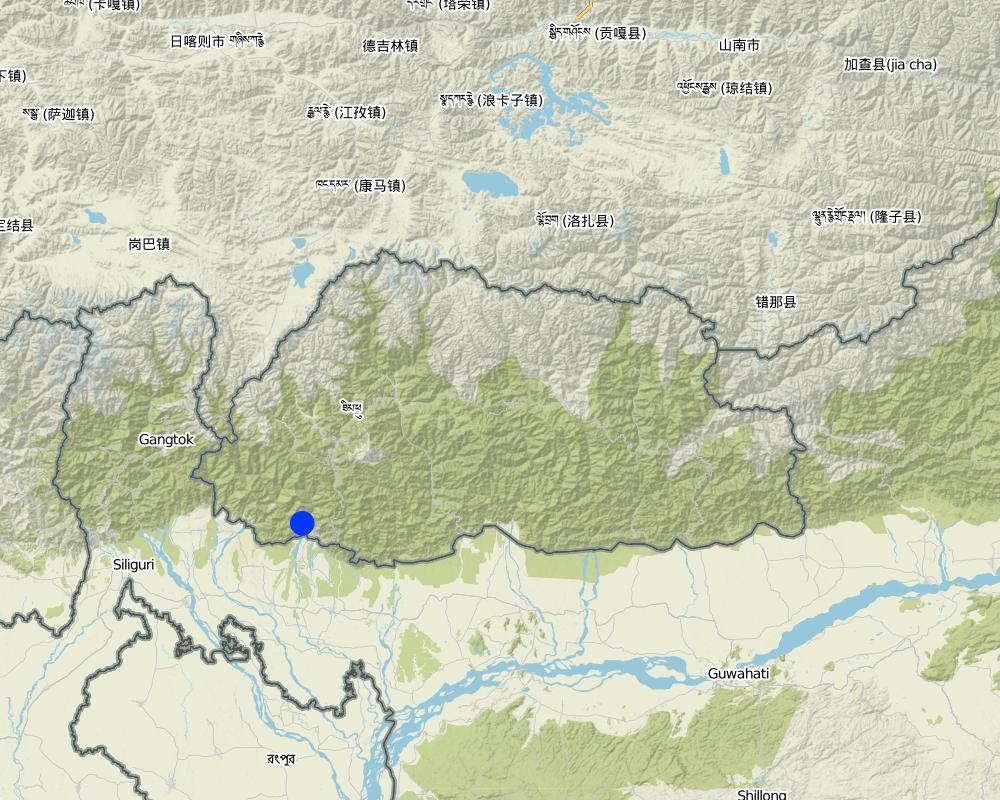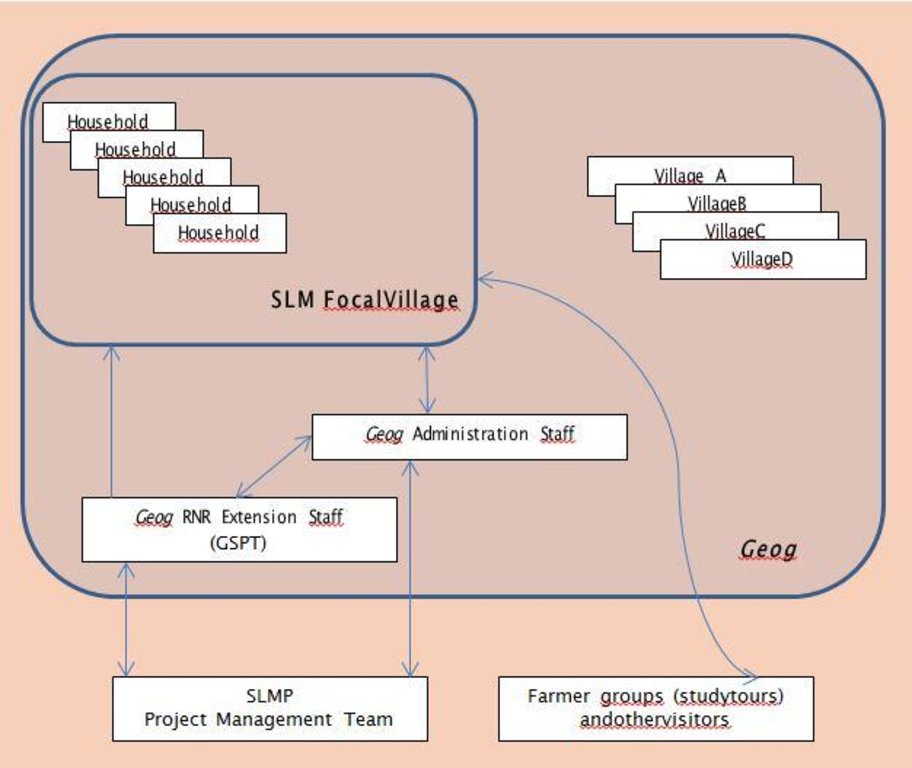SLM Focal Village [ภูฏาน]
- ผู้สร้างสรรค์:
- การอัพเดท:
- ผู้รวบรวม: Karma Dorji
- ผู้เรียบเรียง: –
- ผู้ตรวจสอบ: Fabian Ottiger
approaches_2490 - ภูฏาน
ดูส่วนย่อย
ขยายทั้งหมด ย่อทั้งหมด1. ข้อมูลทั่วไป
1.2 รายละเอียดที่ติดต่อได้ของผู้รวบรวมและองค์กรที่เกี่ยวข้องในการประเมินและการจัดเตรียมทำเอกสารของแนวทาง
ชื่อของโครงการซึ่งอำนวยความสะดวกในการทำเอกสารหรือการประเมินแนวทาง (ถ้าเกี่ยวข้อง)
MoA (MoA) - ภูฏานชื่อของโครงการซึ่งอำนวยความสะดวกในการทำเอกสารหรือการประเมินแนวทาง (ถ้าเกี่ยวข้อง)
National Soil Services Centre (National Soil Services Centre) - ภูฏาน1.3 เงื่อนไขที่เกี่ยวข้องกับการใช้ข้อมูลที่ได้บันทึกไว้ผ่านทาง WOCAT
วันที่เก็บรวบรวมข้อมูล (ภาคสนาม):
20/03/2011
ผู้รวบรวมและวิทยากรหลักยอมรับเงื่อนไขเกี่ยวกับการใช้ข้อมูลที่ถูกบันทึกผ่านทาง WOCAT:
ใช่
1.4 การอ้างอิงถึงแบบสอบถามเรื่องเทคโนโลยี SLM
2. คำอธิบายของแนวทาง SLM
2.1 การอธิบายแบบสั้น ๆ ของแนวทาง
Focused support to a single village community to promote the widespread integrated implementation of SLM interventions.
2.2 การอธิบายอย่างละเอียดของแนวทาง
การอธิบายอย่างละเอียดของแนวทาง:
Aims / objectives: A SLM Focal Village is an approach to focus support to a particular village where a whole range of integrated SLM interventions is showcased in order to create visual impact and to serve as a demonstration site. The concept of a SLM Focal Village was developed in order to tackle the concern of dilution of impact caused by inclusion of all the villages and the households that are geographically very scattered and dispersed. Focal villages are selected at geog (block) level based on their accessibility, visibility for visitors and passers-by, severity of land degradation issues and interest shown by the village community.
Methods: Participatory SLM Action Planning is used to identify land-based problems, their causes and to discuss, select and prioritize specific targeted SLM interventions into a chiog (village) SLM action plan. Additional support is given to the village community to convert larger complexes of clustered land to more sustainable use with locally suited SLM practices. Popular interventions are stone bunding, grass hedgerows, bench terracing, bamboo and tree plantation and fodder development. The for-mation of labour-sharing groups is promoted in the SLM Focal Villages to ease high labour requirement for some SLM activities.
Stages of implementation: Where possible, integrated approaches are adopted, linking increasing vegetative cover of degraded or vulnerable areas with fodder development in marginal slope segments. FYM shed construction is combined with breed improvement and transition to stall feeding, providing manure for cropland. The SLM Focal Villages are used as demonstration sites and interested farmer groups on study tours and other visitors can get a quick impression of a variety of SLM activities showcased in a limited geographical area.
Role of stakeholders: The SLM Focal Villages are used as demonstration sites and interested farmer groups on study tours and other visitors can get a quick impression of a variety of SLM activities showcased in a limited geographical area.
Other important information: SLM Focal Villages require more guidance and monitoring by local extension staff and relatively higher budgets as the areas of land converted to SLM practices are often larger and thus related expenses for seeds, seedlings and other incentives like tools. In some focal villages additional labour-saving machinery is supplied, for example maize flour mill, oil expeller, rice huller, cornflake machine, etc. as an incentive to the community for taking up SLM interventions on comparatively larger scale..
2.3 รูปภาพของแนวทาง
2.5 ประเทศ ภูมิภาค หรือสถานที่ตั้งที่ได้นำแนวทางไปใช้
ประเทศ:
ภูฏาน
ภูมิภาค/รัฐ/จังหวัด: :
Chhukha Dzongkhag
ข้อมูลเฉพาะเพิ่มเติมของสถานที่ตั้ง:
Phuntsholing geog, Serina chiog
Map
×2.6 วันที่เริ่มต้นและสิ้นสุดของแนวทาง
ระบุปีที่เริ่ม:
2009
การสิ้นสุดลง (ถ้าแนวทางไม่ได้ใช้อีกต่อไป):
2012
2.7 ประเภทของแนวทาง
- ใช้โครงงานหรือแผนงานเป็นฐาน
2.8 เป้าหมายหรือวัตถุประสงค์หลักของแนวทาง
The Approach focused mainly on SLM with other activities (Advocay of implementation of various SLM techniques through focus village (chiog) approach)
- Creating a visible and tangible impact at chiog level through widespread implementation of SLM technologies
- Convert present fallow land and former slash-and-burn practice areas to more sustainable cropland with an improved fodder base
- Improve community sense and enhance sustainability of SLM approaches through group support
The SLM Approach addressed the following problems: - Inclusion of all households at village level in a large and geographically dispersed geog leads to dilution of (visual) impact and benefits.
- Targeting individual households makes it more difficult to create a focused demonstration area to showcase SLM interventions at village level
2.9 เงื่อนไขที่เอื้ออำนวยหรือเป็นอุปสรรคต่อการนำเทคโนโลยีภายใต้แนวทางนี้ไปปฏิบัติใช้
การจัดตั้งระดับองค์กร
- เป็นอุปสรรค
Transition of focus from individual household approach to labour-sharing approach, uniting lager groups of community members
Treatment through the SLM Approach: Group support, targeted training and guidance/monitoring
กรอบแนวทางในการดำเนินการด้านกฎหมาย (การถือครองที่ดิน สิทธิในการใช้ที่ดินและน้ำ)
- เอื้ออำนวย
The existing land ownership, land use rights / water rights greatly helped the approach implementation: Individual titled land tenure greatly help implementation of SLM activities as the land users have great commitment and feeling of ownership, getting direct benefits and leading in decision-making process.
ปริมาณงานที่ทำได้ กำลังคนที่มีให้
- เป็นอุปสรรค
Larger areas to be treated with SLM interventions requires substantial work load of all households
Treatment through the SLM Approach: Labour-sharing groups to ease labour constraint and promote/enhance community bonding/sense
อื่นๆ
- เป็นอุปสรรค
Lack of direct tangible impact of long-term SLM interventions
Treatment through the SLM Approach: Combining long-term SLM activities with short-term inputs and incentives and additional capacity building / awareness raising
3. การมีส่วนร่วมและบทบาทของผู้มีส่วนได้ส่วนเสียที่เกี่ยวข้อง
3.1 ผู้มีส่วนได้ส่วนเสียที่เกี่ยวข้องในแนวทางนี้และบทบาท
- ผู้ใช้ที่ดินระดับท้องถิ่นหรือชุมชนระดับท้องถิ่น
Serina chiog community
Households from vulnerable groups (lower “well-being class” after chiog “well-being ranking”) are involved as much as possible in SLM interventions.
- ผู้เชี่ยวชาญ SLM หรือที่ปรึกษาการเกษตร
- รัฐบาลระดับท้องถิ่น
Dzongkhag, geog and chiog administration together with the RNR extension staff and GSPs
- รัฐบาลแห่งชาติ (ผู้วางแผน ผู้ทำการตัดสินใจ)
RGoB, MoAF, DoA, NSSC, SLMP
- องค์การระหว่างประเทศ
ถ้ามีผู้มีส่วนได้ส่วนเสียหลายคนที่เกี่ยวข้องให้ระบุหน่วยงานตัวแทน:
developed as result of internal review of project progress and impact
3.2 การเกี่ยวข้องของผู้ใช้ที่ดินระดับท้องถิ่นหรือชุมชนระดับท้องถิ่นในช่วงต่างๆของแนวทาง
| ความเกี่ยวข้องของผู้ใช้ที่ดินระดับท้องถิ่นหรือชุมชนระดับท้องถิ่น | ระบุผู้ที่มีส่วนเกี่ยวข้องและอธิบายกิจกรรม | |
|---|---|---|
| การริเริ่มหรือการจูงใจ | ปฏิสัมพันธ์ | Initial meetings to sensitize farmers and to create awareness of SLM issues |
| การวางแผน | ปฏิสัมพันธ์ | Participatory SLM action planning at chiog level; annual planning cycle, repeated for 3 years |
| การดำเนินการ | ปฏิสัมพันธ์ | Based on the chiog SLM action plan SLM interventions are implemented with input support and incentives; guidance and capacity building by municipality extension staff and geog SLM planners |
| การติดตามตรวจสอบหรือการประเมินผล | ปฏิสัมพันธ์ | Participatory Monitoring & Evaluation meetings carried out by geogSLM planning team (GSPT) |
| Research | ไม่มี |
3.3 แผนผังแสดงขั้นตอนการทำงาน (ถ้ามี)
คำอธิบาย:
SLM focal village and its linkage with support providers
ผู้เขียน:
Hans van Noord (Schoutenkamp 43 Heteren The Netherlands)
3.4 การตัดสินใจเลือกใช้เทคโนโลยี SLM
ระบุผู้ที่ทำการตัดสินใจเลือกเทคโนโลยีมากกว่าหนึ่งวิธีไปปฏิบัติใช้:
- ผู้ใช้ที่ดินเป็นผู้ตัดสินใจหลัก โดยการสนับสนุนจากผู้เชี่ยวชาญ SLM
การอธิบาย:
the annual participatory SLM Action Planning is key approach used to identify and prioritize SLM technologies for implementation at village level.
Decisions on the method of implementing the SLM Technology were made by mainly by SLM specialists with consultation of land users. based on the SLM Action plan for the village and amended, if necessary, by the findings of M&E meetings
4. การสนับสนุนด้านเทคนิค การสร้างขีดความสามารถ และการจัดการด้านความรู้
4.1 การสร้างขีดความสามารถ / การอบรม
ได้มีการจัดอบรมให้แก่ผู้ใช้ที่ดินหรือผู้มีส่วนได้ส่วนเสียคนอื่น ๆ หรือไม่:
ใช่
ให้ระบุว่าใครเป็นผู้ได้รับการอบรม:
- ผู้ใช้ที่ดิน
ถ้าเกี่ยวข้อง ให้ระบุ เพศ อายุ สถานภาพ ชาติพันธุ์ เป็นต้น:
Whole community involved with SLM: inclusive approach to all 44 households
รูปแบบการอบรม:
- เกษตรกรกับเกษตรกร
- ใช้พื้นที่ทำการสาธิต
- จัดการประชุมสู่สาธารณชน
หัวข้อที่พูด:
A series of awareness raising activities related to identification of local land-based problems, its causes and possible SLM interventions through an annual SLM action planning and following implementation. This is combined with specific technical trainings focused on the SLM activities prioritized in the village SLM action plan.
4.2 การบริการให้คำแนะนำ
ผู้ใช้ที่ดินมีการเข้าถึงการรับบริการให้คำปรึกษาหรือไม่:
ใช่
ระบุว่ามีบริการให้คำปรึกษาหรือไม่:
- ไปเยี่ยมชมสถานที่
การอธิบาย/แสดงความคิดเห็น:
Name of method used for advisory service: Field visits and meetings; Key elements: technical guidance, awareness raising and group formation support
Advisory service is inadequate to ensure the continuation of land conservation activities
4.3 การเสริมความแข็งแกร่งให้กับสถาบัน (การพัฒนาองค์กร)
สถาบันได้รับการจัดตั้งขึ้นมาหรือเสริมความแข็งแกร่งโดยแนวทางนี้หรือไม่:
- ใช่ ปานกลาง
ระบุระดับของสถาบันที่ได้รับการเสริมความแข็งแกร่งหรือจัดตั้งขึ้นมา:
- ท้องถิ่น
ระบุประเภทของการให้ความช่วยเหลือสนับสนุน:
- ด้านการเงิน
- การสร้างขีดความสามารถ / การอบรม
- อุปกรณ์
ให้รายละเอียดเพิ่มเติม :
Yes, SLM focal village development is a direct form of local institution support.
4.4 การติดตามตรวจสอบและประเมินผล
การติดตามตรวจสอบและประเมินผลเป็นส่วนหนึ่งของแนวทางหรือไม่:
ใช่
ความคิดเห็น:
bio-physical aspects were ad hoc monitored by project staff, land users through observations; indicators: terrace area increase and area treated with stone bunds
bio-physical aspects were ad hoc monitored by project staff, land users through measurements; indicators: terrace area increase and area treated with stone bunds
technical aspects were regular monitored by project staff, land users through observations; indicators: Regular observations by project staff with land users of specific SLM interventions: progress, problems, areas for improvement
socio-cultural aspects were regular monitored by project staff, land users through observations; indicators: Regular observations on community / focal village approach through participatory M&E meetings; community sense, conflicts etc.
economic / production aspects were regular monitored by project staff, land users through measurements; indicators: Regular measurements by project staff and land users: crop yields, income, fodder and animal production
area treated aspects were regular monitored by project staff, land users through measurements; indicators: Regular measurements by project staff and land users: area of SLM interventions (hedgerows, stone bunds, bench terraces, # of check dams tec.)
no. of land users involved aspects were regular monitored by project staff, land users through measurements; indicators: Regular measurements by project staff and land users: number of households participating in each specific training and event (male/female)
management of Approach aspects were regular monitored by project staff, land users through observations; indicators: Regular observations by project staff and land users during participatory M&E meetings; ad hoc meetings with project management staff
There were few changes in the Approach as a result of monitoring and evaluation: Adjustment of technical interventions due to farmer feedback during participatory M&E meetings; review of annual SLM action plan leads to readjusted action plans based on evaluation with community on progress and issues.
There were few changes in the Technology as a result of monitoring and evaluation: Adjustment of technical interventions due to farmer feedback during participatory M&E meetings; review of annual SLM action plan leads to readjusted action plans based on evaluation with community on progress and issues.
5. การสนับสนุนด้านการเงินและวัสดุอุปกรณ์
5.1 ระบุงบประมาณประจำปีสำหรับแนวทาง SLM นี้
ถ้าหากว่างบประมาณประจำปีไม่เป็นที่ทราบแน่นอน ให้ระบุช่วงลงไป:
- 10,000-100,000
แสดงความคิดเห็น (แหล่งของการระดมทุน ผู้บริจาคคนสำคัญ):
Approach costs were met by the following donors: international (World Bank GEF): 60.0%; government (RGoB): 20.0%; local community / land user(s): 20.0%
5.2 การสนับสนุนด้านการเงิน / วัสดุอุปกรณ์ให้แก่ผู้ใช้ที่ดิน
ผู้ใช้ที่ดินได้รับการสนับสนุนด้านการเงิน / วัสดุอุปกรณ์ไปปฏิบัติใช้เทคโนโลยีหรือไม่:
ใช่
5.3 เงินสนับสนุนสำหรับปัจจัยนำเข้า (รวมถึงแรงงาน)
- อุปกรณ์
| ระบุปัจจัยนำเข้าที่ได้รับการสนับสนุน | เห็นด้วยระดับไหน | ระบุเงินสนับสนุน |
|---|---|---|
| maize floor mill, green net sheds, water drums | ได้รับการช่วยเหลือทางการเงินบางส่วน | |
- การเกษตร
| ระบุปัจจัยนำเข้าที่ได้รับการสนับสนุน | เห็นด้วยระดับไหน | ระบุเงินสนับสนุน |
|---|---|---|
| เมล็ด | ได้รับการช่วยเหลือทางการเงินแบบเต็ม | maize, paddy, vegetables |
- วัสดุสำหรับการก่อสร้าง
| ระบุปัจจัยนำเข้าที่ได้รับการสนับสนุน | เห็นด้วยระดับไหน | ระบุเงินสนับสนุน |
|---|---|---|
| CGI sjeets, water drums and houses | ได้รับการช่วยเหลือทางการเงินแบบเต็ม | |
- อื่น ๆ
| อื่นๆ (ระบุ) | เห็นด้วยระดับไหน | ระบุเงินสนับสนุน |
|---|---|---|
| incentive payment | ได้รับการช่วยเหลือทางการเงินบางส่วน | per unit area of hedge row and stone bunding |
ถ้าแรงงานโดยผู้ใช้ที่ดินเป็นปัจจัยนำเข้าที่มีอยู่มากมาย ระบุด้วยว่าเนื่องจาก:
- สมัครใจ
ความคิดเห็น:
Labour is mainly voluntary contribution by household, but partly compensated with cash and other material support for the more labour-intensive interventions such as stone bunding and hedgerow establishment; labour-saving groups also supported with tool sets
Tool sets partly financed; seeds and seedlings mostly fully financed; CGI sheets, green net and drums for FYM sheds, green net sheds and water collection drums fully financed; some labour-saving machinery fully financed such as maize flour mill as community incentive.
5.4 เครดิต
มีการจัดหาเครดิตมาให้ภายใต้แนวทาง SLM หรือไม่:
ไม่ใช่
6. การวิเคราะห์ผลกระทบและการสรุป
6.1 ผลกระทบของแนวทาง
ช่วยให้ผู้ใช้ที่ดินนำเอาเทคโนโลยี SLMไปใช้และบำรุงรักษาสภาพไว้ได้หรือไม่:
- ไม่ใช่
- ใช่ เล็กน้อย
- ใช่ ปานกลาง
- ใช่ อย่างมาก
Increased area under SLM treatment with improved fodder availability and formation of SLM related groups (labour-saving group etc.); former slash-and-burn practice area now converted into more sustainable land use; water sources protected and degraded areas afforested.
ปรับปรุงประเด็นของการถือครองที่ดินหรือสิทธิในการใช้ ซึ่งขัดขวางการนำเทคโนโลยีไปใช้ให้ดีขึ้น:
- ไม่ใช่
- ใช่ เล็กน้อย
- ใช่ ปานกลาง
- ใช่ อย่างมาก
Absentee land owners can complicate a full coverage of SLM interventions. The problem is unlikely to be overcome in the near future. Land ownership is a private matter, which is difficult to change land use without permission of abent land owner
Did other land users / projects adopt the Approach?
- ไม่ใช่
- ใช่ เล็กน้อย
- ใช่ ปานกลาง
- ใช่ อย่างมาก
Did the Approach lead to improved livelihoods / human well-being?
- ไม่ใช่
- ใช่ เล็กน้อย
- ใช่ ปานกลาง
- ใช่ อย่างมาก
In terms of increased yield, improved fodder availability and quality and increased production area; enhanced community bonding through group activities and related easing of labour constraints (labour-saving groups).
Did the Approach help to alleviate poverty?
- ไม่ใช่
- ใช่ เล็กน้อย
- ใช่ ปานกลาง
- ใช่ อย่างมาก
Through inclusion in labour-sharing groups labour constraint of vulnerable households addressed. Focus of hands-on training on land of most vulnerable households to give them first benefit and ensure inclusion.
6.2 แรงจูงใจหลักของผู้ใช้ที่ดินเพื่อที่จะนำ SLM ไปปฏิบัติใช้
- การผลิตที่เพิ่มขึ้น
Small immediate increase, but good increase in long-term
- กำไร (ความสามารถ) อัตราส่วนค่าใช้จ่ายต่อผลประโยชน์ที่เพิ่มขึ้น
- ภาระงานลดลง
labour-sharing groups: Reduced workload through improved land (with hedgerows, stone b
- การจ่ายเงินหรือการช่วยเหลือ
incentives and inputs
- กฎและระเบียบ (ค่าปรับ) หรือการบังคับใช้
enforcement through GSPT/community
- จิตสำนึกด้านสิ่งแวดล้อม
environmental awareness
- well-being and livelihoods improvement
wish to improve food self-sufficiency and increase of continuous cropping area
6.3 ความยั่งยืนของกิจกรรมของแนวทาง
ผู้ใช้ที่ดินสามารถทำให้สิ่งต่างๆ ที่ได้ปฏิบัติใช้โดยแนวทางนี้ยั่งยืนได้หรือไม่ (โดยไม่มีการสนับสนุนจากภายนอก):
- ใช่
ถ้าตอบว่าใช่ ให้อธิบายว่าอย่างไร :
Village communities express commitment to continue focal village approach, but it remains to be seen if they actually are able to continue with various SLM activities without support post-project. The communities are intending to continue to convert ex slash-and-burn area to annual cropland, making use of labour-sharing group. This old traditional system is rejuvenated and therefore is more likely to be sustainable post-project.
6.4 จุดแข็งและข้อได้เปรียบของแนวทาง
| จุดแข็ง / ข้อได้เปรียบของแนวทางในทัศนคติของผู้ใช้ที่ดิน |
|---|
|
reduced dependency on forest and tseri (How to sustain/ enhance this strength: maintenance of new annual crop land ) |
| more annual cropland through SLM interventions (How to sustain/ enhance this strength: maintenance of new annual crop land) |
|
better workability of developed cropland (stone bunding / hedgerows etc.) (How to sustain/ enhance this strength: maintenance of new annual crop land) |
| short-term inputs and subsidies enable the poorer households to take up log-term SLM interventions (How to sustain/ enhance this strength: targeted support to vulnerable households to maintain an inclusive approach) |
| จุดแข็ง / ข้อได้เปรียบของแนวทางในทัศนคติของผู้รวบรวมหรือวิทยากรหลัก |
|---|
|
Holistic integrated village development enabling to showcase a variety of SLM interventions (How to sustain/ enhance this strength: Regular technical guidance and targeted capacity building efforts ) |
| Enables to convert larger areas of previous fallow land, or previously under slash-and-burn practice, to more sustainable cropland and reduces dependency on forest and slash-and-burn (How to sustain/ enhance this strength: Regular technical guidance and targeted capacity building efforts, combined with input support and guidance of labour-saving groups) |
| Pressure on communities to change land-use through governmental rule to stop slash-and-burn practice makes them very interested in adopting SLM (How to sustain/ enhance this strength: Regular technical guidance and targeted capacity building efforts, combined with short-term incentives) |
| Group formation process enables labour-sharing approach, which is very well appreciated (How to sustain/ enhance this strength: Regular technical guidance and targeted capacity building efforts) |
6.5 จุดอ่อน / ข้อเสียเปรียบของแนวทางและวิธีในการแก้ไข
| จุดอ่อน / ข้อเสียเปรียบในทัศนคติของผู้ใช้ที่ดิน | สามารถแก้ไขปัญหาได้อย่างไร |
|---|---|
| Increase of work load combined with demand for labour of other developmental activities (rural water supply, road construction etc.). Therefore 'underperformance' against set targets | Better seasonal planning, try to avoid busy agricultural season. |
| จุดอ่อน / ข้อเสียเปรียบในทัศนคติของผู้รวบรวมหรือวิทยากรหลัก | สามารถแก้ไขปัญหาได้อย่างไร |
|---|---|
| Risk of dependency on incentives/inputs: spoon-feeding syndrome |
Continued support to community and labour-saving groups to support land conversion efforts |
|
Focus and concentration of efforts to one community might cause dissatisfaction among neighbouring villages |
Continue SLM support to other villages as planned; communicate reasons of selection clearly: transparency at municipality level. |
| Requires considerable input of labour by community, but clashes with other requirement of developmental activities such as drinking water supply, irrigation channel construction, electrification and farm road construction | Labour-sharing group to ease labour constraint |
7. การอ้างอิงและการเชื่อมต่อ
7.1 วิธีการหรือแหล่งข้อมูล
- ไปเยี่ยมชมภาคสนาม การสำรวจพื้นที่ภาคสนาม
- การสัมภาษณ์กับผู้ใช้ที่ดิน
ลิงก์และโมดูล
ขยายทั้งหมด ย่อทั้งหมดลิงก์
ไม่มีลิงก์
โมดูล
ไม่มีโมดูล


